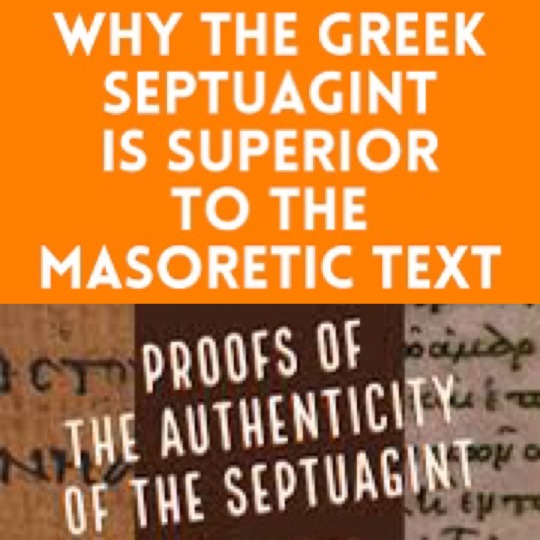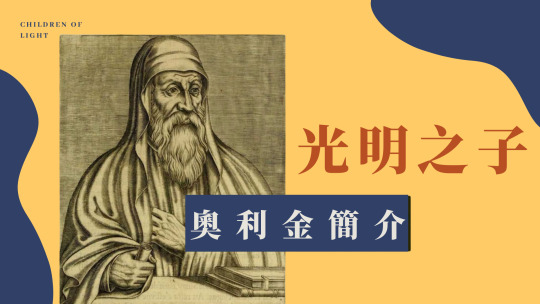#Theodotion
Text

Was the Septuagint Destroyed When the Library of Alexandria Was Burnt Down in 48 BC?
By Author Eli Kittim 🎓
The Argument
Some people (typically Jewish apologists) claim that the Septuagint doesn’t exist because it was destroyed when the Library of Alexandria was burnt down in 48 BC.
This conclusion, however, is both textually misleading & historically erroneous.
First
The Alexandrian Library and its collection were not entirely destroyed. We have evidence that there was only partial damage and that many of its works survived. According to Wiki:
The Library, or part of its collection, was
accidentally burned by Julius Caesar during
his civil war in 48 BC, but it is unclear how
much was actually destroyed and it seems
to have either survived or been rebuilt
shortly thereafter; the geographer Strabo
mentions having visited the Mouseion in
around 20 BC and the prodigious scholarly
output of Didymus Chalcenterus in
Alexandria from this period indicates that
he had access to at least some of the
Library's resources.
Second
The Septuagint had already been written and disseminated among the diaspora since the 3rd century BC, and so many of its extant copies were not housed in the Library of Alexandria per se.
Third
Textual Criticism confirms that the New Testament authors used the Septuagint predominantly and quoted extensively from it. If the Septuagint didn’t exist, where did the New Testament authors copy from? And how do you explain the fact that the New Testament and the Septuagint often have identical wording in their agreements?
Fourth
The Dead Sea Scrolls also demonstrate that the Septuagint was far more accurate than the 10th-century-AD Masoretic text. See, for example, the textual controversy surrounding Deuteronomy 32:8. Both the Dead Sea Scrolls and the Septuagint have “sons of God.” The Masoretic text is demonstrably inaccurate because it has “sons of Israel,” a later redaction. Israel didn’t even exist at that time!
Fifth
Emanuel Tov, a leading authority on the Septuagint who has explained the various textual families (or text-types) of the Old Testament, never once mentioned that we lost the Septuagint, or that it was destroyed, or that it was no longer in circulation. On the contrary, he claims that it continued to be in use during the Christian period and that it is much more older than the 10th-century-AD Masoretic text, which the Jews call the “Hebrew Bible.”
Sixth
If the Septuagint was completely destroyed, as some have erroneously suggested, from where were the later revisionists and translators copying from? We have historical evidence that they were, in fact, copying from the Septuagint itself. Wiki writes:
Theodotion … was a Hellenistic Jewish
scholar, … who in c. 150 CE translated the
Hebrew Bible into Greek. … Whether he was
revising the Septuagint, or was working
from Hebrew manuscripts that represented
a parallel tradition that has not survived, is
debated.
So there’s evidence to suggest that the Theodotion version is a possible *revision* of the Septuagint. This demonstrates that the Septuagint existed in the second century AD! Otherwise, where was Theodotion copying from if the Septuagint didn’t exist?
Seventh
The great work of Origen, Hexapla, compiled sometime before 240 AD, is further proof that the Septuagint was still in use in the 3rd century AD! Wikipedia notes the following:
Hexapla … is the term for a critical edition
of the Hebrew Bible in six versions, four of
them translated into Greek, preserved only
in fragments. It was an immense and
complex word-for-word comparison of the
original Hebrew Scriptures with the Greek
Septuagint translation and with other Greek
translations.
Encyclopedia Britannica adds:
In his Hexapla (“Sixfold”), he [Origen]
presented in parallel vertical columns the
Hebrew text, the same in Greek letters, and
the versions of Aquila, Symmachus, the
Septuagint, and Theodotion, in that order.
Eighth
Besides Origen’s Hexapla, we also have extant copies of the Septuagint. According to wiki:
Relatively-complete manuscripts of the
Septuagint postdate the Hexaplar
recension, and include the fourth-century-
CE Codex Vaticanus and the fifth-century
Codex Alexandrinus. These are the oldest-
surviving nearly-complete manuscripts of
the Old Testament in any language; the
oldest extant complete Hebrew texts date
to about 600 years later, from the first half
of the 10th century.
Ninth
There’s also historical and literary evidence that the Greek Septuagint was in wide use during the Christian period and beyond. Wiki says:
Greek scriptures were in wide use during
the Second Temple period, because few
people could read Hebrew at that time. The
text of the Greek Old Testament is quoted
more often than the original Hebrew Bible
text in the Greek New Testament
(particularly the Pauline epistles) by the
Apostolic Fathers, and later by the Greek
Church Fathers.
Tenth
Today, Biblical scholarship has a *critical edition* of the Septuagint. If it was destroyed in 48 BC, where did the critical edition come from? The Göttingen Septuaginta (editio maior) presents *a fully critical text* and should silence the skeptics and critics who try to mislead the public. They deliberately mislead the public by trying to discredit the far more reliable and much older Septuagint in order to get people to accept the much later Hebrew Masoretic text from the Middle Ages!
#lxx#septuagint#Library of Alexandria#Strabo#textual criticism#Masoretic#EliKittim#NewTestamentGreek#dead sea scrolls#Deuteronomy32v8#EmanuelTov#SBL#Theodotion#the little book of revelation#HebrewScriptures#origen#Hexapla#aquila#julius caesar#IOSCS#Symmachus#ελικιτίμ#GreekOldTestament#critical edition#ΜετάφρασητωνΕβδομήκοντα#biblicalgreek#GöttingenSeptuaginta#τομικρόβιβλίοτηςαποκάλυψης#ΕλληνιστικήΚοινή#ΑγίαΓραφή
9 notes
·
View notes
Text
Wives and Daughters of Byzantine Emperors: Ages at First Marriage
I have only included women whose birth dates and dates of marriage are known within at least 1-2 years, therefore, this is not a comprehensive list.
Theodora, wife of Justinian I; age 35 when she married Justinian in 435 AD
Constantina, wife of Maurice; age 22 when she married Maurice in 582 AD
Eudokia, wife of Heraclius; age 30 when she married Heraclius in 610 AD
Fausta, wife of Constans II; age 12 when she married Constans in 642 AD
Maria of Amnia, wife of Constantine VI; age 18 when she married Constantine in 788 AD
Theodote, wife of Constantine VI; age 15 when she married Constantine in 795 AD
Euphrosyne, wife of Michael II; age 33 when she married Michael in 823 AD
Theodora, wife of Theophilos; age 15 when she married Theophilos in 830 AD
Eudokia Dekapolitissa, wife of Michael III; age 15 when she married Michael in 855 AD
Eudokia Ingerina, wife of Basil I; age 25 when she married Basil in 865 CE
Theophano Martinakia, wife of Leo VI; age 16/17 when she married Leo in 882/883 AD
Helena Lekapene, wife of Constantine VII; age 9 when she married Constantine in 919 AD
Theodora, wife of John I Tzimiskes; age 25 when she married John in 971 AD
Theophano, wife of Romanos II (and later Nikephoros II); age 14 when she married Romanos in 955 AD
Anna Porphyrogenita, daughter of Romanos II; age 27 when she married Vladimir in 990 AD
Zoe Porphyrogenita, wife of Romanos III (and later Michael IV & Constantine IX); age 50 when she married Romanos in 1028 AD
Eudokia Makrembolitissa, wife of Constantine X Doukas (and later Romanos IV Diogenes); age 19 when she married Constantine in 1049 AD
Maria of Alania, wife of Michael II Doukas (and later Nikephoros III Botaniates); age 12 when she married Michael in 1065 AD
Irene Doukaina, wife of Alexios I Komnenos; age 11 when she married Alexios in 1078 AD
Anna Komnene, wife of Nikephoros Bryennios the Younger; age 14 when she married Nikephoros in 1097 AD
Maria Komnene, daughter of Alexios I Komnenos; age 14/15 when she married Nikephoros Katakalon in 1099/1100 AD
Eudokia Komnene, daughter of Alexios Komnenos; age 15 when she married Michael Iasites in 1109 AD
Theodora Komnene, daughter of Alexios Komnenos; age 15 when she married Constantine Kourtikes in 1111 AD
Maria of Antioch, wife of Manuel I Komnenos; age 16 when she married Manuel in 1161 AD
Euphrosyne Doukaina Kamatera, wife of Alexios III Angelos; age 14 when she married Alexios in 1169 AD
Maria Komnene, daughter of Manuel I Komnenos; age 27 when she married Renier of Montferrat in 1179 AD
Anna of France, wife of Alexios II Komnenos (and later Andronikos Komnenos); age 9 when she married Alexios in 1180 AD
Eudokia Angelina, daughter of Alexios III Angelos; age 13 when she married Stefan Nemanjic in 1186 AD
Margaret of Hungary, wife of Isaac II Angelos; age 11 when she married Isaac in 1186 AD
Anna Komnene Angelina, daughter of Alexios III Angelos; age 14 when she married Isaac Komnenos Vatatzes in 1190 AD
Irene Angelina, daughter of Isaac II Angelos; age 16 when she married Philip of Swabia in 1197 AD
Philippa of Armenia, wife of Theodore I Laskaris; age 31 when she married Theodore in 1214 AD
Maria of Courtenay, wife of Theodore I Laskaris; age 15 when she married Theodore in 1219 AD
Maria Laskarina, daughter of Theodore I Laskaris; age 12 when she married Bela IV of Hungary in 1218 AD
Elena Asenina of Bulgaria, wife of Theodore II Laskaris; age 11 when she married Theodore in 1235 AD
Anna of Hohenstaufen, wife of John III Doukas Vatatzes; age 14 when she married John in 1244 AD
Theodora Palaiologina, wife of Michael VIII Palaiologos; age 13 when she married Michael in 1253 AD
Anna of Hungary, wife of Andronikos II Palaiologos; age 13 when she married Andronikos in 1273 AD
Eudokia Palaiologina, daughter of Michael VIII Palaiologos; age 17 when she married John II Megas Komnenos in 1282 AD
Irene of Montferrat, wife of Andronikos II Palaiologos; age 10 when she married Andronikos in 1284 AD
Rita of Armenia, wife of Michael IX Palaiologos; age 16 when she married Michael in 1294 AD
Simonis Palaiologos, daughter of Andronikos II Palaiologos; age 5 when she married Stefan Milutin in 1299 AD
Irene of Brunswick, wife of Andronikos III Palaiologos; age 25 when she married Andronikos in 1318 AD
Anna of Savoy, wife of Andronikos III Palaiologos; age 20 when she married Andronikos in 1326 AD
Irene Palaiologina, daughter of Andronikos III Palaiologos; age 20 when she married Basil of Trebizond in 1335 AD
Maria-Irene Palaiologina, daughter of Andronikos III Palaiologos; age 9 when she married Michael Asen IV of Bulgaria in 1336 AD
Theodora Kantakouzene, daughter of John VI Palaiologos; age 16 when she married Orhan Gazi in 1346 AD
Helena Kantakouzene, wife of John V Palaiologos; age 13 when she married John in 1347 AD
Keratsa of Bulgaria, wife of Andronikos IV Palaiologos; age 14 when she married Andronikos in 1362 AD
Helena Dragas, wife of Manuel II Palaiologos; age 20 when she married Manuel in 1392 AD
Anna of Moscow, wife of John VIII Palaiologos; age 21 when she married John in 1414 AD
Maria Komnene, wife of John VIII Palaiologos; age 23 when she married John in 1427 AD
Helena Palaiologina, daughter of Theodore II Palaiologos; age 14 when she married John II of Cyprus in 1442 AD
Helena Palaiologina, daughter of Thomas Palaiologos; age 15 when she married Lazar Brankovic in 1446 AD
Sophia Palaiologina, daughter of Thomas Palaiologos; age 23 when she married Ivan III of Russia in 1472 AD
The average age at first marriage was 17 years old.
14 notes
·
View notes
Text
Nephilim
The Nephilim are mysterious beings or people in the Hebrew Bible who are described as being large and strong. The word Nephilim is loosely translated as giants in most translations of the Hebrew Bible, but left untranslated in others. Some Jewish explanations interpret them as hybrid sons of fallen angels (demigods).

The main reference to them is in Genesis 6:1–4, but the passage is ambiguous and the identity of the Nephilim is disputed. According to the Book of Numbers 13:33, a report from ten of the Twelve Spies was given of them inhabiting Canaan at the time of the Israelite conquest of Canaan.
A similar or identical biblical Hebrew term, read as "Nephilim" by some scholars, or as the word "fallen" by others, appears in the Book of Ezekiel 32:27 and is also mentioned in the deuterocanonical books Judith 16:6, Sirach 16:7, Baruch 3:26–28, and Wisdom 14:6.
Etymology
The Brown-Driver-Briggs Lexicon (1908) gives the meaning of Nephilim as "giants", and holds that proposed etymologies of the word are "all very precarious". Many suggested interpretations are based on the assumption that the word is a derivative of Hebrew verbal root n-p-l "fall." Robert Baker Girdlestone argued in 1871 the word comes from the hif'il causative stem, implying that the Nephilim are to be perceived as 'those that cause others to fall down'. Ronald Hendel states that it is a passive form: 'ones who have fallen', grammatically analogous to paqid 'one who is appointed' (i.e., a deputy or overseer), asir 'one who is bound' (i.e., a prisoner), etc.
The majority of ancient biblical translations – including the Septuagint, Theodotion, Latin Vulgate, Samaritan Targum, Targum Onkelos, and Targum Neofiti – interpret the word to mean "giants". Symmachus translates it as "the violent ones" and Aquila's translation has been interpreted to mean either "the fallen ones" or "the ones falling [upon their enemies]."
In the Hebrew Bible, there are three interconnected passages referencing the nephilim. Two of them come from the Pentateuch. The first occurrence is in Genesis 6:1–4, immediately before the account of Noah's Ark. Genesis 6:4 reads as follows:
Where the Jewish Publication Society's translation simply transliterates the Hebrew nephilim as "Nephilim", the King James Version translates the term as "giants".
The nature of the Nephilim is complicated by the ambiguity of Genesis 6:4, which leaves it unclear whether they are the "sons of God" or their offspring who are the "mighty men of old, men of renown". Richard Hess takes it to mean that the Nephilim are the offspring, as does P. W. Coxon.
The second is Numbers 13:32–33, where ten of the Twelve Spies report that they have seen fearsome giants in Canaan:
Outside the Pentateuch there is one more passage indirectly referencing nephilim and this is Ezekiel 32:17–32. Of special significance is Ezekiel 32:27, which contains a phrase of disputed meaning. With the traditional vowels added to the text in the medieval period, the phrase is read gibborim nophlim ("'fallen warriors" or "fallen Gibborim"), although some scholars read the phrase as gibborim nephilim ("Nephilim warriors" or "warriors, Nephilim"). According to Ronald S. Hendel, the phrase should be interpreted as "warriors, the Nephilim" in a reference to Genesis 6:4. The verse as understood by Hendel reads:
Brian R. Doak, on the other hand, proposes to read the term as the Hebrew verb "fallen" , not a use of the specific term "Nephilim", but still according to Doak a clear reference to the Nephilim tradition as found in Genesis.
Interpretations:
Giants
Most of the contemporary English translations of Genesis 6:1–4 and Numbers 13:33 render the Hebrew nefilim as "giants". This tendency in turn stems from the fact that one of the earliest translations of the Hebrew Bible, the Septuagint, composed in the 3rd or 2nd century BCE, renders the said word as gigantes. The choice made by the Greek translators has been later adopted into the Latin translation, the Vulgate, compiled in the 4th or 5th century CE, which uses the transcription of the Greek term rather than the literal translation of the Hebrew nefilim. From there, the tradition of the giant progeny of the sons of God and the daughters of men spread to later medieval translations of the Bible.
The decision of the Greek translators to render the Hebrew nefilim as Greek gigantes is a separate matter. The Hebrew nefilim means literally "the fallen ones" and the strict translation into Greek would be peptokotes, which in fact appears in the Septuagint of Ezekiel 32:22–27. It seems then that the authors of Septuagint wished not only to simply translate the foreign term into Greek, but also to employ a term which would be intelligible and meaningful for their Hellenistic audiences. Given the complex meaning of the nefilim which emerged from the three interconnected biblical passages (human–divine hybrids in Genesis 6, autochthonous people in Numbers 13 and ancient warriors trapped in the underworld in Ezekiel 32), the Greek translators recognized some similarities. First and foremost, both nefilim and gigantes were liminal beings resulting from the union of the opposite orders and as such retained the unclear status between the human and divine. Similarly dim was their moral designation and the sources witnessed to both awe and fascination with which these figures must have been looked upon. Secondly, both were presented as impersonating chaotic qualities and posing some serious danger to gods and humans. They appeared either in the prehistoric or early historical context, but in both cases they preceded the ordering of the cosmos. Lastly, both gigantes and nefilim were clearly connected with the underworld and were said to have originated from earth, and they both end up closed therein.
In 1 Enoch, they were "great giants, whose height was three hundred cubits". A cubit being 18 inches (46 cm), this would make them 450 feet (140 m) tall.
The Quran refers to the people of Ād in Quran 26:130 whom the prophet Hud declares to be like jabbarin (Hebrew: gibborim), probably a reference to the Biblical Nephilim. The people of Ād are said to be giants, the tallest among them 100 ft (30 m) high. However, according to Islamic legend, the ʿĀd were not wiped out by the flood, since some of them had been too tall to be drowned. Instead, God destroyed them after they rejected further warnings. After death, they were banished into the lower layers of hell.
Fallen angels
All early sources refer to the "sons of heaven" as angels. From the third century BCE onwards, references are found in the Enochic literature, the Dead Sea Scrolls (the Genesis Apocryphon, the Damascus Document, 4Q180), Jubilees, the Testament of Reuben, 2 Baruch, Josephus, and the book of Jude (compare with 2 Peter 2). For example: 1 Enoch 7:2 "And when the angels, (3) the sons of heaven, beheld them, they became enamoured of them, saying to each other, Come, let us select for ourselves wives from the progeny of men, and let us beget children." Some Christian apologists, such as Tertullian and especially Lactantius, shared this opinion.
The earliest statement in a secondary commentary explicitly interpreting this to mean that angelic beings mated with humans can be traced to the rabbinical Targum Pseudo-Jonathan and it has since become especially commonplace in modern Christian commentaries. This line of interpretation finds additional support in the text of Genesis 6:4, which juxtaposes the sons of God (male gender, divine nature) with the daughters of men (female gender, human nature). From this parallelism it could be inferred that the sons of God are understood as some superhuman beings.
The New American Bible commentary draws a parallel to the Epistle of Jude and the statements set forth in Genesis, suggesting that the Epistle refers implicitly to the paternity of Nephilim as heavenly beings who came to earth and had sexual intercourse with women. The footnotes of the Jerusalem Bible suggest that the biblical author intended the Nephilim to be an "anecdote of a superhuman race".
Some Christian commentators have argued against this view, citing Jesus's statement that angels do not marry. Others believe that Jesus was only referring to angels in heaven.
Evidence cited in favor of the fallen angels interpretation includes the fact that the phrase "the sons of God" ("sons of the gods") is used twice outside of Genesis chapter 6, in the Book of Job (1:6 and 2:1) where the phrase explicitly references angels. The Septuagint manuscript Codex Alexandrinus reading of Genesis 6:2 renders this phrase as "the angels of God" while Codex Vaticanus reads "sons".
Targum Pseudo-Jonathan identifies the Nephilim as Shemihaza and the angels in the name list from 1 Enoch.
Second Temple Judaism
The story of the Nephilim is further elaborated in the Book of Enoch. The Greek, Aramaic, and main Ge'ez manuscripts of 1 Enoch and Jubilees obtained in the 19th century and held in the British Museum and Vatican Library, connect the origin of the Nephilim with the fallen angels, and in particular with the egrḗgoroi (watchers). Samyaza, an angel of high rank, is described as leading a rebel sect of angels in a descent to earth to have sexual intercourse with human females:
In this tradition, the children of the Nephilim are called the Elioud, who are considered a separate race from the Nephilim, but they share the fate of the Nephilim.
Some believe the fallen angels who begat the Nephilim were cast into Tartarus (2 Peter 2:4, Jude 1:6) (Greek Enoch 20:2), a place of "total darkness". An interpretation is that God granted ten percent of the disembodied spirits of the Nephilim to remain after the flood, as demons, to try to lead the human race astray until the final Judgment.
In addition to Enoch, the Book of Jubilees (7:21–25) also states that ridding the Earth of these Nephilim was one of God's purposes for flooding the Earth in Noah's time. These works describe the Nephilim as being evil giants.
There are also allusions to these descendants in the deuterocanonical books of Judith (16:6), Sirach (16:7), Baruch (3:26–28), and Wisdom of Solomon (14:6), and in the non-deuterocanonical 3 Maccabees (2:4).
The New Testament Epistle of Jude (14–15) cites from 1 Enoch 1:9, which many scholars believe is based on Deuteronomy 33:2. To most commentators this confirms that the author of Jude regarded the Enochic interpretations of Genesis 6 as correct; however, others have questioned this.
Descendants of Seth and Cain
References to the offspring of Seth rebelling from God and mingling with the daughters of Cain are found from the second century CE onwards in both Christian and Jewish sources (e.g., Rabbi Shimon bar Yochai, Augustine of Hippo, Sextus Julius Africanus, and the Letters attributed to St. Clement). It is also the view expressed in the modern canonical Amharic Ethiopian Orthodox Bible: Henok 2:1–3 "and the Offspring of Seth, who were upon the Holy Mount, saw them and loved them. And they told one another, 'Come, let us choose for us daughters from Cain's children; let us bear children for us.'"
Orthodox Judaism has taken a stance against the idea that Genesis 6 refers to angels or that angels could intermarry with men. Shimon bar Yochai pronounced a curse on anyone teaching this idea. Rashi and Nachmanides followed this. Pseudo-Philo (Biblical Antiquities 3:1–3) may also imply that the "sons of God" were human. Consequently, most Jewish commentaries and translations describe the Nephilim as being from the offspring of "sons of nobles", rather than from "sons of God" or "sons of angels". This is also the rendering suggested in the Targum Onqelos, Symmachus and the Samaritan Targum, which read "sons of the rulers", where Targum Neophyti reads "sons of the judges".
Likewise, a long-held view among some Christians is that the "sons of God" were the formerly righteous descendants of Seth who rebelled, while the "daughters of men" were the unrighteous descendants of Cain, and the Nephilim the offspring of their union. This view, dating to at least the 1st century CE in Jewish literature as described above, is also found in Christian sources from the 3rd century if not earlier, with references throughout the Clementine literature, as well as in Sextus Julius Africanus, Ephrem the Syrian, and others. Holders of this view have looked for support in Jesus' statement that "in those days before the flood they [humans] were ... marrying and giving in marriage" (Matthew 24:38, emphasis added).
Some individuals and groups, including St. Augustine, John Chrysostom, and John Calvin, take the view of Genesis 6:2 that the "Angels" who fathered the Nephilim referred to certain human males from the lineage of Seth, who were called sons of God probably in reference to their prior covenant with Yahweh (cf. Deuteronomy 14:1; 32:5); according to these sources, these men had begun to pursue bodily interests, and so took wives of "the daughters of men", e.g., those who were descended from Cain or from any people who did not worship God.
This also is the view of the Ethiopian Orthodox Church, supported by their own Ge'ez manuscripts and Amharic translation of the Haile Selassie Bible—where the books of 1 Enoch and Jubilees, counted as canonical by this church, differ from western academic editions. The "Sons of Seth view" is also the view presented in a few extra-biblical, yet ancient works, including Clementine literature, the 3rd century Cave of Treasures, and the c. 6th century Ge'ez work The Conflict of Adam and Eve with Satan. In these sources, these offspring of Seth were said to have disobeyed God, by breeding with the Cainites and producing wicked children "who were all unlike", thus angering God into bringing about the Deluge, as in the Conflict:
Arguments from culture and mythology
In Aramaic culture, the term niyphelah refers to the Constellation of Orion and nephilim to the offspring of Orion in mythology. However the Brown–Driver–Briggs lexicon notes this as a "dubious etymology" and "all very precarious".
J. C. Greenfield mentions that "it has been proposed that the tale of the Nephilim, alluded to in Genesis 6 is based on some of the negative aspects of the Apkallu tradition." The apkallu in Sumerian mythology were seven legendary culture heroes from before the Flood, of human descent, but possessing extraordinary wisdom from the gods, and one of the seven apkallu, Adapa, was therefore called "son of Ea" the Babylonian god, despite his human origin.
Arabian paganism
Fallen angels were believed by Arab pagans to be sent to earth in form of men. Some of them mated with humans and gave rise to hybrid children. As recorded by Al-Jahiz, a common belief held that Abu Jurhum, the ancestor of the Jurhum tribe, was actually the son of a disobedient angel and a human woman.
Fossil remains
Alleged discoveries of Nephilim remains have been a common source of hoaxing and misidentification.
In 1577, a series of large bones discovered near Lucerne were interpreted as the bones of an antediluvian giant about 5.8 m (19 ft) tall. In 1786, Johann Friedrich Blumenbach found out that these remains belonged to a mammoth. Cotton Mather believed that fossilized leg bones and teeth discovered near Albany, New York, in 1705, were the remains of nephilim who perished in a great flood. Paleontologists have identified these as mastodon remains.
9 notes
·
View notes
Text
im really out here like. my blorbo from my career is now "the torah's and also the biblical manuscript tradition" like what am i supposed to do with that. the entire book of samuel is my blorbo. theodotion's jeremiah is my blorbo. i am constantly rotating the fraught relationship and nonetheless deeply robust textual interchange between jewish and late-antique christian communities in my head. but i can't talk about it because i am so sure that people are going to look at me and think i am a weird christian blogger and it is KILLING ME!!!!
#i literally can't believe my autism is doing this like on the one hand it's thrilling and i feel deeply fulfilled. on the other hand.#imagine having to learn the bible because you genuinely want to and love it. that's what's giving me body horror here.#(specifically 'the bible' and not the torah because of how manuscript traditions happened to survive but NOT the christian-specific stuff.)#do i BELIEVE in it? that's none of your or anyone else's business. do i turn into a tbh creature the second i think of her? shut up!!!!!!!!
25 notes
·
View notes
Text
Saints&Reading: Thursday, January 4, 2024
december 22_january 4
Forefeast of the nativity of Christ

THE GREATMARTYR ANASTASIA THE DELIVERER FROM POISON, HER TEACHER MARTYR CHRYSOGOMOS AND MANY WITH THEM (304)

The Great Martyr Anastasia (Anastasía) the Deliverer from Poisons, was a Roman by birth, who suffered for Christ during Diocletian’s persecution of Christians, circa 304. Her father was a pagan, and her mother Fausta was a secret Christian. As a child, Anastasia’s teacher was an educated and pious Christian named Chrysogonos (Chrysógonos). After the death of her mother, Anastasia's father gave her in marriage to a pagan named Publius, but by feigning illness, she preserved her virginity.
Clothing herself in the garb of a beggar, and accompanied by only one servant, she visited the prisons. She fed, treated, and often ransomed captives who were suffering for their faith in Christ. When her servant told Publius about this, he beat his wife and confined her in his house. Then Anastasia began to correspond secretly with Chrysogonos, who told the Saint to be patient, to cleave to the Cross of Christ, and to accept the Lord’s will. He also foretold the impending death of Publius in the ocean. Publius did drown, as he was setting out for Persia with a delegation. After her husband's death, Anastasia distributed her property to the poor and suffering.
Diocletian was informed that the Christians who filled the prisons of Rome stoically endured their torments. He commanded that all of them should be put to death in a single night, and that Chrysogonos be sent to him at Aquileia. Anastasia followed her teacher at a distance.
The Emperor interrogated Chrysógonos personally, but could not make him deny Christ. Therefore, he commanded that he be decapitated and thrown into the sea. The Holy Martyr's body and severed head were carried to shore by the waves. There by Divine Providence, the relics were found by a priest named Zoilos (Zoϊlos), who placed them in a coffer, and concealed them in his home.
Saint Chrysogonos appeared to Zoilos and informed him that three sisters who lived nearby, Agape (Agápē), Chionia (Χιονὶα), and Irene (April 16), would soon suffer martyrdom for Christ. He told him to send Saint Anastasia to them to encourage them. Saint Chrysogonos foretold that Zoilos would also die on the same day. Nine days later, the words of Saint Chrysogonos were fulfilled. Zoilos fell asleep in the Lord, and Saint Anastasia visited the three maidens before their tortures. After these three Martyrs surrendered their souls to God, she buried them.
After carrying out her teacher’s request, the Saint went from city to city ministering to Christian prisoners. Proficient in the medical arts of the time, she zealously cared for captives far and wide, healing their wounds and relieving their suffering. Because of her labors, Saint Anastasia was known as the Deliverer from Potions (Pharmakolytria),1 since by her intercessions she has healed many from the effects of potions, poisons, and other harmful substances.
She made the acquaintance of the pious young widow named Theodótē, finding in her a faithful helper. When it was learned that she was a Christian, Theodote was brought in for questioning. Meanwhile, Saint Anastasia was arrested in Illyricum. This occurred just after all the Christian captives there had been murdered in a single night by Diocletian's order. Saint Anastasia went to one of the prisons, and finding no one there, she began to weep loudly. The jailers realized that she was a Christian and took her to the prefect of that district, who tried to persuade her to deny Christ by threatening her with torture. After his unsuccessful attempts to persuade Anastasia to offer sacrifice to idols, he handed her over to the pagan priest Ulpian in Rome.
The cunning pagan told Saint Anastasia to choose between luxury and riches, or grievous sufferings. He set before her gold, precious stones and fine clothing, as well as fearsome instruments of torture. The crafty man was put to shame by the bride of Christ. Saint Anastasia refused the riches and chose the tools of torture.
But the Lord prolonged the earthly life of the Saint, and Ulpian gave her three days to reconsider. Charmed by Anastasia’s beauty, the pagan priest decided to defile her. However, when he tried to touch her he suddenly became blind. His head began to ache so severely that he screamed like a madman. He asked to be taken to a pagan temple to pray to the idols for help, but on the way he fell down and died.
Saint Anastasia was set free and she and Theodote devoted themselves once more to the care of imprisoned Christians. Before long, Saint Theodote and her three sons received the crown of martyrdom. Her eldest son, Euódos2 stood bravely before the judge and endured his beatings without protest. After much torture, they were all thrown into a red-hot oven.
Saint Anastasia was caught again and condemned to death by starvation. She remained in prison without food for sixty days. Saint Theodote appeared to the Martyr every night and gave her courage. Seeing that hunger caused Saint Anastasia no harm whatsoever, the judge sentenced her to drowning together with other prisoners. Among them was Eutychianos (Εὐτυχιανὸς), who was condemned for his Christian Faith.
The prisoners were put into a boat which went out into the open sea. The soldiers bored holes in the boat and got into a galley. Saint Theodote appeared to the captives and steered the ship to shore. When they reached dry land, 120 men believed in Christ and were baptized by Saints Anastasia and Eutychianos. All were captured and received a martyr’s crown. Saint Anastasia was stretched between four pillars and burned alive. A certain pious woman named Apollinaria buried her body, which was unharmed by the fire, in the garden outside her house.
In the fifth century, Saint Anastasia's relics were transferred to Constantinople, where a church was built and dedicated to her. Later her head and one of her hands were transferred to the Monastery of Saint Anastasia, near Mount Athos.
Source: Orthodox Church in America_OCA


JAMES 1:19-27
19 So then, my beloved brethren, let every man be swift to hear, slow to speak, slow to wrath; 20 for the wrath of man does not produce the righteousness of God. 21 Therefore lay aside all filthiness and overflow of wickedness, and receive with meekness the implanted word, which is able to save your souls. 22 But be doers of the word, and not hearers only, deceiving yourselves. 23 For if anyone is a hearer of the word and not a doer, he is like a man observing his natural face in a mirror; 24 for he observes himself, goes away, and immediately forgets what kind of man he was. 25 But he who looks into the perfect law of liberty and continues in it, and is not a forgetful hearer but a doer of the work, this one will be blessed in what he does. 26 If anyone among you thinks he is religious, and does not bridle his tongue but deceives his own heart, this one's religion is useless. 27 Pure and undefiled religion before God and the Father is this: to visit orphans and widows in their trouble, and to keep oneself unspotted from the world.
MARK 10:17-27
17 Now as He was going out on the road, one came running, knelt before Him, and asked Him, "Good Teacher, what shall I do that I may inherit eternal life?" 18 So Jesus said to him, "Why do you call Me good? No one is good but One, that is, God. 19 You know the commandments: 'Do not commit adultery,' 'Do not murder,' 'Do not steal,' 'Do not bear false witness,' 'Do not defraud,' 'Honor your father and your mother.' 20 And he answered and said to Him, "Teacher, all these things I have kept from my youth." 21 Then Jesus, looking at him, loved him, and said to him, "One thing you lack: Go your way, sell whatever you have and give to the poor, and you will have treasure in heaven; and come, take up the cross, and follow Me." 22 But he was sad at this word, and went away sorrowful, for he had great possessions. 23 Then Jesus looked around and said to His disciples, "How hard it is for those who have riches to enter the kingdom of God!" 24 And the disciples were astonished at His words. But Jesus answered again and said to them, "Children, how hard it is for those who trust in riches to enter the kingdom of God! 25 It is easier for a camel to go through the eye of a needle than for a rich man to enter the kingdom of God. 26 And they were greatly astonished, saying among themselves, "Who then can be saved?" 27 But Jesus looked at them and said, "With men it is impossible, but not with God; for with God all things are possible."
#orthodoxy#orthodoxchristianity#easternorthodoxchurch#originofchristianity#spirituality#holyscriptures#gospel#bible#wisdom#saints
2 notes
·
View notes
Note
Im really in a brain rot right now where i need as many obscure information about alcibiades life as possible and i was just cery curious about the heraita that watched him die , timandra . Is there any actual information on them knowing eachother before then or any information about her life not mentioned in plutarch?
Ah I feel you.
Alright I'll try to get it all straight because the whole thing is confusing.
First of all, we don't know for sure that she existed or that she was there when Alcibiades died. It's very likely that it's a made up story.
Now. Timandra (or Damasandra) is mentioned in Athenaeus' Deipnosophists as the mother of Lais and Theodote (both also hetairas). In the same text, the lais mentioned is Lais the Corinthian, and she can be found speaking with euripides. Later, there's mention of an oration by Lysis against her. (Another interesting bit is that the aforementioned Theodote is mentioned in xenophon's memorabilia where Socrates is like "lets go see if her bosom is as beautiful as they say) .
Continuing with athenaeus' Deipnosophists, there's also mention of another hetaira also named Lais, who was from hyccara, and who lived a generation or two after lais the Corinthian who was timandra's daughter.
So, lais from corinth lived the same time as euripides and Socrates, while lais of hyccara lived the same time as Diogenes.
From these details we have that: what makes sense is for Timandra to be the mother of the Corinthian Lais. What's weird to me is that if you go on Wikipedia, Timandra is mentioned as the mother of the other Lais, which is chronologically much less likely and also goes against what athenaeus says.
I have been unable to find other original sources for Timandra. I must also note that athenaeus is writting this hundreds of years later, so we can't fully trust him either.
I think it's possible that these had become at that point kind of like "default hetairas" when later authors were writing for older time periods, and that's why Alcibiades' companion is named that, it was just an "hetaira name".
I hope this isn't too confusing, and if anyone has any other sources, do let me know :') there's very little information about Timandra. al
4 notes
·
View notes
Text

artist - theodote gericault (insane woman)
#theodore gericault#im going insane#crazy#no likes#tumblr blog#this is insane#kms#kys <3#painting#grunge#why#like my post#please
1 note
·
View note
Text
Defense Innovation Board Holds Spring 2024 Meeting
View Online
IMMEDIATE RELEASE
Defense Innovation Board Holds Spring 2024 Meeting
April 18, 2024
The Defense Innovation Board (DIB) held its Spring Board Meeting virtually on April 17th, 2024. At 12:30 pm Eastern Time, DIB Executive Director and Designated Federal Officer, Dr. Marina Theodotou, called the meeting into session. The DIB Chair, Mr. Mike Bloomberg, and Board Members discussed the…

View On WordPress
0 notes
Text

Hl. Cyrus der Arme
gefeiert am 31. Januar
Hl. Cyrus der Arme
Mönch, Märtyrer
* in Alexandria in Ägypten
† vor 312 am Roten Meer in Arabien
Cyrus war ein Heilmittelkundiger in Alexandria. Zur Zeit der Christenverfolgung floh er in ein Kloster am Roten Meer, wurde Mönch und ob seiner Heilkunst berühmt. Eines Tages schloss sich auch Johannes ihm an. Schließlich wurde er doch festgenommen, gemartert und enthauptet.
Athanasia und ihre Töchter Theodote, Theoktiste and Eudoxia wurden von Griechen ob ihres Christseins gefangen genommen; als Cyrus und Johannes dies hörten, gingen sie zu den Frauen, um sie in der Standhaftigkeit des Glaubens zu stützen, wurden gefangen genommen, gefoltert und schließlich zusammen mit den Frauen enthauptet.
Christen bestatteten ihre Körper in der Kirche des Markus. Im 5. Jahrhundert wurden die Reliquien von Johannes und Cyrus von Canopis nach Manuphin - beide Orte nahe Alexandria - überführt, später kamen sie nach Rom, dann nach München.
#saints#heiliger des tages#selig#roman catholic#religion#jesus#god#gott#christ#worship#christianity#christentum#faith#glaube#holy#heilig#catholic#katholisch#römisch katholisch#catholicism#holy vibe#lord here I am#römisch katholische kirche#betrachtung#lord here i am#Cyrus der Arme#Mönch#Märtyrer
0 notes
Text

光明之子--奧利金簡介
奧利金(Origen),是古代基督教希臘教會的著名的神學家和哲學家,是亞歷山大學派《聖經》學者、釋經家和靈修作者。生於公元185年,卒於公元251年。他是希臘教父,更是亞歷山大學派的重要代表人物之一。
奧利金出生於埃及亞歷山大的一個基督徒家庭,從小受到良好的基督教教育。公元202年,亞歷山大爆發逼迫,他的父親殉道;若不是母親悄悄把他的衣服藏起來,奧利金就會跟隨他父親的腳步一同殉道。
逼迫平息之後,他在亞歷山大開始教導的工作,繼前任克萊門特之後被當地的主教德米特裏任命為教理學校的帶領者。奧利金也由此開始嚴格生活,操練禁食、守夜禱告和守貧。
他積極主張輪回觀念。
奧利金對《聖經》非常喜愛,自動不斷地背誦,以至於《聖經》已成為他思想的一部分。奧利金花費20年的時間,雇傭了許多抄錄員、眷寫員,整理並對照著校勘希伯來文的《舊約·聖經》和希臘文的《舊約·聖經》。
由72位猶太學者及阿奎拉(Aquila),西馬庫斯(Symmachus)與迪奧多蒂翁(Theodotion)翻譯成希臘文的《舊約·聖經》。由於奧利金對希伯來文的精通,以及對譯本的分歧的比較,他為教會提供了一本最正確的希臘文譯本《七十子希臘文本聖經》(Senptuagint),他又在《聖經》的每卷書上加註釋,有時這些註釋占極大的篇幅。
奧利金認為信徒應堅信基督教的基本教義信條,但又可自由探索。奧利金一直是希臘神學史上最有影響的教父。
奧利金著作有《論原理》、《反賽爾索》等。奧利金所編訂的《六種經文合參》是早期基督教的偉大傑作,在早期東西方教會眾教父中,奧利金是最有影響力的一位。
他的思想為後世基督教神學奠定了深厚的基礎。與他同時代以及後來的教父和聖徒都或多或少地得益於他,有「眾聖之師」之美譽。
公元215年,奧利金從亞歷山大來到巴勒斯坦,在該撒利亞主教的邀請下講道。因為奧利金平信徒的身份,這一舉動被認為違背了亞歷山大教會的紀律,因而被主教德米特裏召回。
之後的15年裏,奧利金投身於寫作和學習中。公元230年,他再一次去往巴勒斯坦,被當年邀請他講道的當地主教按立神職。
正是由於這一非常規的按立,他在亞歷山大的校長職位和教會身份被德米特裏一並剝奪。奧利金也不得不離開亞歷山大,定居該撒利亞,在那裏繼續辦學、著書、講道,聲名遠播。
奧利金 (Origen) 的《論首要原理》是基督教思想家首次對基督教信仰的理論化的系統闡述。原文用希臘文撰寫,後來由四世紀的拉丁教父魯菲努譯成拉丁文。
公元250年,基督教還沒有得到羅馬帝國的認可,在羅馬皇帝德西烏斯掀起的全國性迫害中,奧利金長期遭受牢獄之災和酷刑折磨,終於在逼迫平息後的數年中因傷以殉道者的身份而死。
奧利金作為東部希臘教會的思想領袖,一生著作等身。不幸的是,他的作品多半都已經不傳,奧利金最重要的神學作品《論首要原理》中,借助希臘概念首次完成了對基督教信仰的體系化工作。
他僅存的靈修作品包括《論禱告》(On Prayer)和《對殉道的勸勉》,兩者皆寫於逼迫時期,在古代世界廣為流傳。
奧利金的《駁塞爾修斯》是前尼西亞教會護教作品中的高峰,也是他有關基督徒政治責任和社會框架討論的主要來源。和他的異教前輩一樣,塞爾修斯將基督徒視為一股敵對政府、瓦解羅馬帝國的反政治力量。
奧利金則回應說,基督徒相信正是神將政治責任賦予皇帝,而且基督教信仰是促進社會道德和凝聚力的。
奧利金並沒有正面回答為什麽參與戰爭是錯誤的,而是認為教會因為類似祭司的職分應當從流血中被分別出來,專註在禱告的侍奉上。而且每座城中的基督徒已經屬於一個被分別出來的人群,他們就不應在帝國中再擔任公職。
然而,當塞爾修斯提到如果羅馬帝國一旦歸信就將無力阻擋侵略者時,奧利金的回應則頗有創意。奧利金描繪了一幅政治意義上的終末景象,即整個帝國的歸信必然會帶來其世界性的、理性的普世統治。這種法律(nomos)與理性(logos)在哲學上的聯系和統一是柏拉圖主義的常見主題,造就了政治層面的理想範式(即哲學王,類似於中國儒家文化的內聖外王)。
正是從這裏出發,奧利金認為羅馬就是要完成其普世帝國的歷史使命,只要這個帝國的人民全部歸信基督。由此也不難想見,這一願景已經為之後諸如優西比烏對君士坦丁的擁戴做好了預備。
基督教經過幾個世紀的急劇發展,已經形成氣候,但教會內部卻形成了各種派��;加上大批知識分子進入教會,產生了對教會原初信仰教義化、體系化的需要,亦產生了多樣化的詮釋和爭執。
奧利金的神學思想發展為奧利金主義,後來引起極大的辯論。支持他的其中有著名教父亞他那修和巴西流。此些爭議最後被提到公元553年的第二次君士坦丁堡公會議被定為異端。
作為一名有希臘文化背景的基督教思想家,奧利金面對社會知識階層,將原始信仰體系化,這與普通信眾的一般需求有很大的差距,因而無法得到教會的承認。
漢斯·昆(Hans Küng) 認為:「這是教會史上發生的在一個君權製的主教與一個自由的基督教教師之間的第一次大沖突,在教會權力與靈性權威之間的第一次大沖突,在體製化的教會領導權與專業神學之間的第一次大沖突。」這是奧利金的悲劇,也是許多基督教思想家的悲劇。
奧利金輪回的觀點,在公元553年以後才被教權定為異端,被教廷所刪除,在此之前,早期基督徒並不否認輪回的觀點。作為一個現代基督徒,大家應該知道這段歷史。
youtube
1 note
·
View note
Text
"What makes us free is the Gnosis
of who we were,
of what we have become;
of where we were,
of wherein we have been cast;
of whereto we speed
of wherefrom we are redeemed,
of what birth truly is,
and of what rebirth truly is."
— Excerpta ex Theodot

0 notes
Text
Trumpet Bibliography
Bibliography
Created by Henri Selmer Paris, French, founded 1885, American Created by Vincent Bach Corporation founded 1918, and American Owned by Louis Armstrong 1901 - 1971. 1946. ‘Trumpet Owned by Louis Armstrong’, JSTOR < https://www.jstor.org/stable/community.31888128 > [accessed 4 May 2023]
Hargreaves, Tracy, 'Feminist Review' The power of the ordinary Subversive in Jackie Kay's "Trumpet"', No.74 (2003), 2-16 < https://www.jstor.org/stable/1395948?searchText=Jacki+kay+trumpet&searchUri=%2Faction%2FdoBasicSearch%3FQuery%3DJacki%2Bkay%2Btrumpet&ab_segments=0%2Fbasic_search_gsv2%2Fcontrol&refreqid=fastly-default%3A08a2f2132402aa5040595219d6d9b241&seq=4 > [Accessed 2 May 2023]
Kay, Jackie, Trumpet (Pan Macmillan, 2016), MacBook
Kay, Jackie and Tournay-Theodotou, Petra, 'Transition' "Some Connection with the Place" , (2014), 82-101 < https://www.jstor.org/stable/10.2979/transition.113.82?searchText=Jacki+kay+trumpet&searchUri=%2Faction%2FdoBasicSearch%3FQuery%3DJacki%2Bkay%2Btrumpet&ab_segments=0%2Fbasic_search_gsv2%2Fcontrol&refreqid=fastly-default%3A62a4d03c0414defc64c7ac45f503c5b2&seq=7 > [Accessed 2 May 2023]
(n.n), ‘Central Music’ The Trumpet, (n.d.) < https://www.schoolmusiconline.com/the-trumpet# > [Accessed 3 May 2023]
0 notes
Text
Odbierz swoje drzewko
Departament Leśnictwa będzie rozdawał sadzonki drzew.
Departament Leśnictwa będzie rozdawał sadzonki drzew
Każdy będzie mógł odebrać sadzonkę drzewa i posadzić w przydomowym ogródku.
Sadzonki będzie można odebrać w ciągu godziny począwszy od:
W Nikozji, 3 grudnia 2022 roku, od godziny 10:00:
Plac Eleftheria (na początku ulicy Ledra)
Makarios Avenue (parking na skrzyżowaniu ulic Zenas Kanther i Theofanous Theodotou)
Park Narodowy Athalassa…

View On WordPress
0 notes
Text
The Septuagint's Translation of Daniel 12.1-2 Suggests an Eschatological Messianic Resurrection
By Author Eli Kittim
The Hebrew name מִיכָאֵל (i.e. Mikha'el) means "who is like God?". It is a rhetorical question, the implication of which is that no person is like God. Interestingly enough, the biblical terminology used to describe Michael is often similar to that of the Messiah. For example, "the archangel Michael" (Jude 1.9), who is described in the Old Testament as "one of the chief princes" (Dan. 10.13), is clearly identified with Christ the "anointed prince" (Dan. 9.25) in 1 Thess. 4.16:
"For the Lord himself, with a cry of command, with the archangel's call and with the sound of God's trumpet, will descend from heaven, and the dead in Christ will rise first" (NRSV).
In Dan. 12.1 there is a reference to a great prince named Michael, depicted as "the protector of your people," who “shall arise” during the time of the great ordeal (i.e. the great tribulation).
The so-called ‘Theodotion Daniel’ form of the LXX translates the Hebrew term עָמַד aw-mad (i.e. "shall arise") as *ἀναστήσεται*, meaning a bodily resurrection.
The Theodotion Daniel (Δανιηλ 12.1) reads:
Καὶ ἐν τῷ καιρῷ ἐκείνῳ ἀναστήσεται Μιχαήλ ὁ ἄρχων ὁ μέγας, ὁ ἑστηκὼς ἐπὶ τοὺς υἱοὺς τοῦ λαοῦ σου· καὶ ἔσται καιρὸς θλίψεως, θλίψις οἵα οὐ γέγονεν ἀφ’ οὗ γεγένηται ἔθνος ἐν τῇ γῇ, ἕως τοῦ καιροῦ ἐκείνου·
Translation:
"At that time Michael, the great prince, the protector of your people, shall arise. There shall be a time of anguish, such as has never occurred since nations first came into existence" (NRSV).
The Old Greek (LXX) goes on to say:
καὶ πολλοὶ τῶν καθευδόντων ἐν τῷ πλάτει τῆς γῆς ἀναστήσονται, οἱ μὲν εἰς ζωὴν αἰώνιον, οἱ δὲ εἰς ὀνειδισμόν, οἱ δὲ εἰς διασπορὰν καὶ αἰσχύνην αἰώνιον (Dan. 12.2).
It is translated as follows:
"Many of those who sleep in the dust of the earth shall awake, some to everlasting life, and some to shame and everlasting contempt" (NRSV).
The word *ἀναστήσεται* is the future middle indicative from ἀνίστημι, which is the root word of *ἀνάστασις* and means to ‘raise up’ or to 'raise from the dead.' Accordingly, notice how the term *ἀναστήσεται* in its singular and plural form conveys the meaning of resurrection. In the Th Dan. 12.1, we have the singular form *ἀναστήσεται* ("shall arise"). Similarly, *ἀναστήσονται* (the plural form in the OG Dan. 12.2) represents an explicit reference to a resurrection from the dead, thereby establishing its meaning. And since both of these resurrection events (namely, Michael's resurrection followed by the general resurrection of the dead) are set for "the time of the end" (Dan. 12.4), the implication is that they are eschatological in nature!

#LXX#ἀνίστημι#resurrection#biblicalgreek#septuagint#Theodotion#daniel12v1#daniel12v2#ἀναστήσεται#ἀναστήσονται#biblestudy#eschatology#bibletranslation#shallarise#scholarlystudies#KoineGreek#Eli_of_Kittim_Bible_Exegesis_Group#EK#Author EK#EK ministry#ek ministries#eli kittim ministry#eli kittim ministries#ministry of kittim#ministries of kittim#eli of kittim ministry#eli of kittim ministries
5 notes
·
View notes
Photo

"𝑰𝒕 𝒘𝒂𝒔 𝒅𝒆𝒗𝒂𝒔𝒕𝒂𝒕𝒊𝒏𝒈 𝒂𝒇𝒕𝒆𝒓 𝒊 𝒍𝒐𝒔𝒕 𝒎𝒚 𝒇𝒂𝒎𝒊𝒍𝒚"
14 notes
·
View notes
Text










he teens posed for a photoshoot at the photobooth, to remember this great party.
•First are Crown Prince Shen of Komorebi Empire and Lady Himawari Amano dressed as steam punk magicians
•Secondly Princess Jade and Crown Princess Sophia of Bridleton Bay dressed as a witch and a mermaid
•Third Princess Royal Victoria and Princess Anne-Marie of Simparthia dressed as Joan of Arc and Daenerys Targaryen from GoT
•Next is Princess Amberley dressed as the Scarlett Witch
•Then Crown Prince Nicholas of Vaestronia and Princess Charlotte of Silvis dressed as Victor and Emily from the corpse bride.
•After them are Princess Anneliese and Leonardo Ward dressed as a witch and a dragon.
•Duke Alexander of Hohenwaldau looked stunning as a pirate
•And last but not least Prince Theodot and Prince Cairo of Vaestronia dressed as a sexy devil and a cowboy from the wild west.
Collab with @silvis-royal-family , @simparthiapalace , @simaliaroyals
#thesims#thesims4#simsta#simstagram#simstagrammer#instasims#simcas#cas#ts4royalfamily#maxismatch#sims4legacy#simsfamily#thesims4cc#thesimslife#thesims4story#thesimscc#thesims4ccfinds#thesimscommunity#thesimsstory#thesims4roleplay#simsstory#simslife#simscc#sims4cc#sims4life#simstories#simstory#simstagrams
11 notes
·
View notes